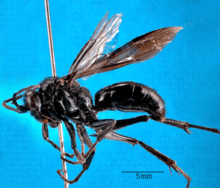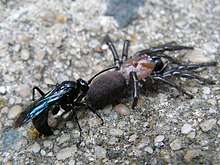Priocnemis monachus
Priocnemis monachus is a large spider wasp from New Zealand where it is known as the "black hunting wasp". It is the largest pompilid in New Zealand.
| Priocnemis monachus | |
|---|---|
 | |
| Scientific classification | |
| Kingdom: | Animalia |
| Phylum: | Arthropoda |
| Class: | Insecta |
| Order: | Hymenoptera |
| Family: | Pompilidae |
| Genus: | Priocnemis |
| Species: | P. monachus |
| Binomial name | |
| Priocnemis monachus (Smith 1855) | |
Taxonomy
Priocnemis monachus was first described in 1855 as Pompilus monachus.[1] In the many years following its description, the genus name was changed several times but has currently settled on Priocnemis.[2] Synonyms of P. monachus include P. monarchus (a misspelling) and P. triangularis.[3][2]
Distribution/habitat
Priocnemis monachus is endemic and widespread in New Zealand where it occupies habitats where its prey are abundant.[2][4] Typically, the wasps will nest in exposed banks in forests, but may also nest in sand and gardens.[5]
Description
Adults of Priocnemis monachus have a metallic bluish-black colouration. The males tend to be smaller than the female, but size is variable even within the same sex. The female reaches up to 26mm in length whilst the male may reach 19mm in length. The body is covered in black hairs.[2]
Hosts/prey
Priocnemis monachus are parasitoids. an adult, the wasp will paralyze large spiders, primarily mygalomorphs, and drag them back to their nest to be used as food for the wasps larvae. Known hosts of P. monachus includes Porrhothele antipodiana, Cantuaria, Hexathele, Dolomedes minor and Miturga.[2] [6]P. monachus prefers spiders which make lidless burrows in the soil.[4] As adults, the wasp will feed on fruit and nectar from a variety of available plants such as Leptospermum scoparium (flowers) and Pennantia corymbos (drupes).[2]

References
- Smith, F. 1855: Catalogue of hymenopterous insects in the collection of the British Museum, London, printed by order of the trustees. Part 3: Mutillidae and Pompilidae. (pp. 164).https://doi.org/10.5962/bhl.title.8766
- Harris, A. C. (Anthony Clifford) (1987). Pompilidae (Insecta: Hymenoptera). New Zealand. Department of Scientific and Industrial Research. Wellington, N.Z.: Science Information Publishing Centre, DSIR. ISBN 0-477-02501-3. OCLC 17796347.
- Hutton, F. W. 1874: List of the insects recorded as having been found in New Zealand previous to the year 1870. Transactions and proceedings of the New Zealand Institute 6: 158-171.
- T.E.R:R.A.I.N - Taranaki Educational Resource: Research, Analysis and Information Network
- Harris, Anthony C. (1999). "The Life Histories and Nesting Behaviour of the Pompilidae (Hymenoptera) in New Zealand : A Comparative Study". Species Diversity. 4 (1): 143–235. doi:10.12782/specdiv.4.143.
- Thompson, S.A. (2020). Records of spider parasites in New Zealand. The Wētā 54:65-72.